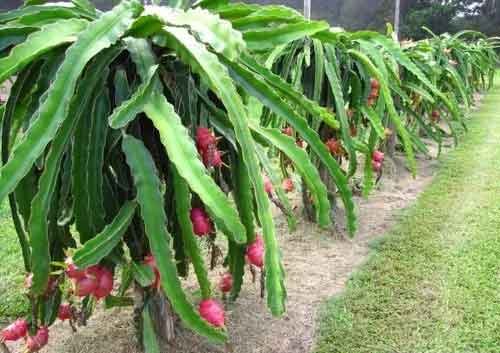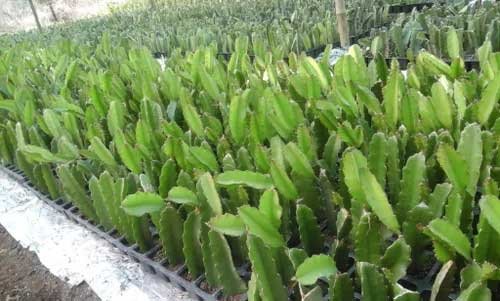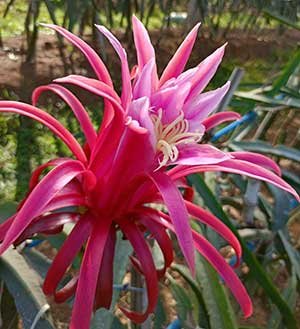Dragon fruit cultivation is a highly profitable business right now. Despite high initial investment dragon fruit has become a sensation among farmers for high return and farmland under this crop is growing rapidly.
Dragon fruit which is also known as ‘Pitaya’ or ‘Pitahaya’ is mainly consumed fresh in India but it can be processed into various products like cubes, chips, powder, juice, jelly, ice cream, various desserts and confectioneries etc.
Dragon Fruit Overview
| Scientific Name | Hylocereus undatus |
| Soil | No specific soil requirement, even degraded poor shallow soil with good drainage is suitable but loamy soil with high organic matter and pH range between 5.5-6.5 is preferred for good harvest. |
| Climate | 20o-30oC temperature, 500-1500mm rainfall and elevation of up to 1700m altitude from sea level is ideal. Even high temperature and low rainfall areas are also suitable. |
| Harvest | Harvesting starts within 16-20 months and lasts for at least 20-25 years. |
| Yield | 5-8 kg/plant, 20-30 kg/pole and 6-10 tonnes/acre |
| Crop Type | Fruit |

Potential Area
Dragon fruit is relatively new in India but popularity among farmers is growing rapidly. Most of the farms are new and established in the last 4-5 years. Maharashtra, Gujarat, Karnataka, Kerala, Tamil Nadu, Andhra Pradesh, Telangana, Odisha, West Bengal and Andaman & Nicobar Islands were main producers but it has now extended to Punjab, Haryana, Uttar Pradesh, Madhya Pradesh, Rajasthan and NE States.
As per a report by ICAR-NIASM, farmland under dragon fruit cultivation is growing rapidly from 400 hectares in 2017 to 3000-4000 hectares in 2020. Any area with a mild to moderate tropical climate is suitable for dragon fruit farming.
Dragon Fruit Cultivation Method
There are four varieties of dragon fruit by colour- red skin white flesh, red skin red flesh, red skin pink flesh and yellow skin white flesh. The variety for cultivation should be selected as per consumer demand and market price.
Dragon fruit is a climbing plant that needs vertical support. A 2ft X 2ft X 2ft pit is dug and a concrete pole of 6-7 ft height is placed at the centre of the pit and filled with topsoil mixed with farmyard manure(1:1). The pole should not be too tall or too short and the above-ground height should be around 5ft. A ring made of concrete or waste bike tyre is placed on top of the pole to hold the plants. Other support systems like ladder or trellis systems may also be utilised.

Dragon fruit plants can be propagated through seeds and cuttings. Commercial plantations are done using cuttings due to their fast fruiting and quality assurance. Good quality rooted planting material should be procured from trusted nursery or fellow farmers. The length of the planting material should be at least 8-10 inches above soil. Four plants are planted per pole on four faces of the pole.
Spacing
Optimal spacing should be adopted according to sunlight, humidity, soil, interculture, etc. Below are the most common spacing adopted for dragon fruit in India.
| Spacing | Poles/acre | Plants/acre |
| 6.5ft X 6.5 ft | 1031 | 4124 |
| 8ft X 6.5ft | 837 | 3348 |
| 10ft X 5ft | 871 | 3364 |
| 12ft X 8ft | 453 | 1812 |
| 10ft X 10ft | 435 | 1740 |
| 13ft X 10ft | 335 | 1340 |
Dragon Fruit Management
Dragon fruit is a low maintenance plant and does not require much care. During the initial vegetative growth fertiliser containing “N” is applied but “K” rich fertiliser is needed when fruiting starts. Organic manures also work well in dragon fruits.
When the plant starts growing, excess stems and lateral shoots are pruned and 2-3 main stems with few lateral shoots are left. The plants are also given support by tying the stems with the pole and eventually the stems are trained to hang from the top ring.
There are no major pest and disease problems except sunburn in extreme tropical climates (over 38°C). This can be controlled by installing a shade net or planting shade trees. Moringa, Melia dubia, etc. are popular options with dragon fruit which not only provide shade but also increase overall income/acre.
Harvesting and Yield

The plants start fruiting within 16-20 months and it takes 30-35 days from fruiting to harvesting. The plants bear fruits in few flushes and the harvesting season lasts about 6 months a year. Yield and size of the fruits are quite low during the initial years but stabilise from the third year. The weight of a single fruit varies from 200-850 gm. Properly managed orchards with drip irrigation gives better yield. A well-established orchard with excellent management can yield 6-10 tonnes/acre or more.
Should You Grow Dragon Fruit?
Reasons to Grow Dragon Fruit
- Barren, degraded, poor and drought prone dryland can be converted into a highly profitable productive orchard.
- Low maintenance and input once established, fewer diseases, fast fruiting and relatively stable production.
- Increased demand in the domestic and export market due to its taste and health benefits.
- Current demand is more than production and dragon fruit farming is highly remunerative at this moment.
Reasons Not to Grow Dragon Fruit
- Initial investment is very high, Rs. 300,000-400,000/acre.
- Very little to no public knowledge about the fruit. Outside metro cities and selected shopping malls the fruit is still unknown to the general public and marketing to them would need higher efforts.
- The area under dragon fruit is growing rapidly and the production could exceed demand in near future. The early birds have already made a huge profit but late comers may face uncertainty in market price in future as the economic life of the crop is quite high (20-25 years).
- Lack of standard protocol and quality planting materials.
A Sample Dragon Fruit Cultivation Project
This is a sample project of dragon fruit cultivation on 1 acre of land with a pole-to-pole spacing of 12ft X 8ft. In this spacing, there will be 453 poles and 1812 plants per acre as a single pole can support 4 plants. The cost of a concrete pole with T support is considered Rs. 500 and the cost of a well rooted potted dragon fruit plant is considered Rs. 50. The wholesale market price varies widely ranging from Rs. 70 to Rs. 200 or even more. In this sample report the average selling price of the fruit is considered Rs. 80/kg. Labour per manday is assumed Rs. 300. It is assumed that a borewell and pump is pre-installed.
Dragon Fruit Farming Profit
| Item | 1st Year | 2nd Year | 3rd Year |
| Income | |||
| Yield per acre (kg) | 500 | 6,000 | 10,000 |
| Total Income | 40,000 | 4,80,000 | 8,00,000 |
| Expenditure | |||
| Land preparation | 1,600 | 0 | 0 |
| Rooted plants | 90,600 | 0 | 0 |
| Concrete pole with T support | 2,26,500 | 0 | 0 |
| Drip irrigation | 45,000 | 0 | 0 |
| Fertilisers and manures | 5,000 | 5,000 | 5,000 |
| Pesticides | 10,000 | 10,000 | 10,000 |
| Irrigation | 3,000 | 6,000 | 6,000 |
| Labour and maintenance | 80,000 | 50,000 | 50,000 |
| Total Expenditure | 4,61,700 | 61,000 | 61,000 |
| Net Income | -4,21,700 | 4,19,000 | 7,39,000 |
The yield of dragon fruit increases in the initial 3 years and then stabilises and continues for next 20-25 years. The cost of cultivation can be reduced by utilising the government subsidy in drip irrigation and other inputs.
Thanks for your correct information.
If have any other information please send through my mail.
Hi did you more information pls confirm once
Where to contact for plant